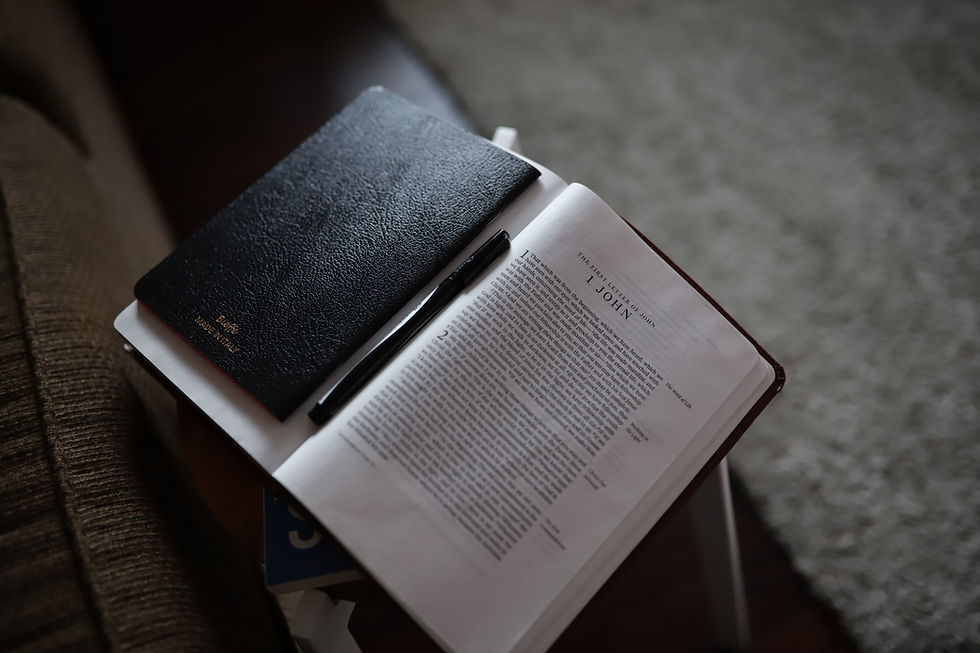A Guide to Receiving Holy Communion Online
- Sean Stanfield
- Aug 14, 2023
- 2 min read
As a fully online congregation, we continually seek creative and meaningful ways to worship, be connected with one another, and serve our communities. We understand that the Sacraments are a communal activity. They are designed to be celebrated at an open table in the presence of the gathered assembly of a local congregation. And yet, the very nature of our movement prevents us from living this practice, as experienced by our fellow Christians who physically gather under one roof on Sunday mornings.
While we do not stream our service of Holy Communion as a part of our worship, we offer opportunities for our community to share together in this vital part of our faith. What follows is a simple guide developed by a sister congregation in the North Georgia Conference of the United Methodist Church on how a church member could set up space in their home, have those elements consecrated by their pastor online, administer and receive the elements, and dispose of them properly afterward.
As United Methodists, we believe all are welcome at God’s Table. Our communion liturgy begins with words spoken on Jesus’ behalf, inviting “all who love him, who earnestly repent of their sin, and seek to live in peace with one another.” We pray this statement describes all who come to Christ’s Table to partake in this Holy mystery.
What type of elements are acceptable?
If, at all possible, use bread and grape juice.The type of bread doesn’tmatter (i.e. sandwich bread, wheat bread, buns, pita, flatbread, etc.). In place of bread a cracker would be an acceptable substitute.
Are there items we shouldn’t use?
Yes. Please do not use items that “water down” the sacred nature of the Eucharist. For example: stay away from flavored crackers or goldfish, don’t use potato chips and soda, avoid things like Goldfish, avoid apple juice. Again, the desire is to allow the Communion elements to have a sacred feel. This is a holy meal and a holy moment; let’s allow it to be just that.
How should we set up Holy Communion?
Consider the following ideas:
Find a plate and cup/glass in your home that is NOT used on a frequent basis. Perhaps it’s a piece of fine china, a plate you picked up while traveling in a foreign country you’ve never eaten off of, a crystal goblet, or a dish used only during the holidays, or items that are family heirloom pieces and are typically for display. Following this simple guideline will allow the bread and cup to be “set apart” for this sacred purpose and not seen as regular or ordinary.
Before the service starts on Sunday, take the bread out of the container, place on the plate and cover it with a napkin. Second, pour the grape juice into your cup. Cover the juice with a napkin.
Once you have prepared your Communion elements, place them in a special location. Try to create a holy space for them in a visible location. Perhaps a mantle or the center of your dining or kitchen table. Allow them to be the centerpiece rather than another item on an already crowded surface.
How do we administer and receive the elements?
Once an ordained elder, has led you through the liturgy, prayed the prayer of consecration saying, “Pour out your Holy Spirit on us gathered here, and on these gifts of bread and wine. Make them be for us the body and blood of Christ, that we may be for the world the body of Christ, redeemed by his blood,” you will be invited to share the elements with others. During these intervening moments, take time to pray for one another, for friends and family, and concerns and situations around the world. Think about those whom you ordinarily worship with and lift them up in prayer. In short, transform this time as you receive Holy Communion and the brief moments afterwards into an opportunity for intercession on behalf of others.
What do we say as we share the elements?
Break the bread into pieces and say to one another, “The body of Christ, given for you” or "The bread of life, given for you." Once everyone has a piece of bread, you can then share the cup and say to one another, “The blood of Christ, given for you” or "The cup of salvation, given for you." Each person should take turns dipping the bread into the cup, and then everyone can receive the elements together. Afterwards, the presiding elder for the online service will pray a prayer of thanksgiving and then transition into the next portion of the service.
What if I don’t have those elements available or don’t want to participate?
If you do not have the necessary items available or were unable to secure them prior to the service, or if you do not want to participate, use this time for prayer. We will pray a blessing over those not taking part in communion.
What do we do with leftovers?
Please remember that these are consecrated elements. Dispose of them in a sacred fashion. Since the elements came from the ground (wheat, grapes, etc.) they should go back into the ground. Thus, break the bread into small pieces and scatter them outside and pour the juice onto the ground.
Keep in mind
Holy Communion is a sacred moment and God has invited us to the Table, and it might be less important whether the Table of the Lord is in the church building or in your own home. If you’d like to read further about our United Methodist understanding of Holy Communion, visit www.umc.org/en/content/ask-the-umc-what-do-i-need-to-know- about-holy-communion-in-the-united-methodist-church.

Comments